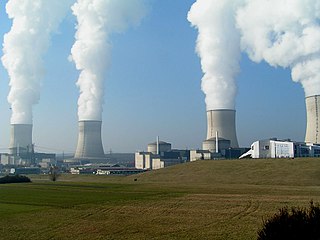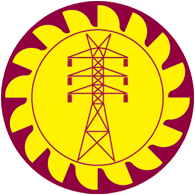An energy crisis is any significant bottleneck in the supply of energy resources to an economy. In literature, it often refers to one of the energy sources used at a certain time and place, in particular, those that supply national electricity grids or those used as fuel in industrial development and population growth have led to a surge in the global demand for energy in recent years. In the 2000s p, this new demand — together with Middle East tension, the falling value of the US dollar, dwindling oil reserves, concerns over peak oil, and oil price speculation — triggered the 2000s energy crisis, which saw the price of oil reach an all-time high of $147.30 a barrel in 2008
A rolling blackout, also referred to as rotational load shedding, feeder rotation, or a rotating outage is an intentionally-engineered electrical power shutdown in which electricity delivery is stopped for non-overlapping periods of time over different parts of the distribution region. Rolling blackouts are a last-resort measure used by an electric utility company to avoid a total blackout of the power system.

The Afghan Ministry of Energy and Water is a ministry of the government of Afghanistan. Following the U.S. invasion of Afghanistan the ministry had the task of co-ordinating an effort to reintroduce power to areas of Afghanistan that had been cut off. Areas particularly badly affected were southern regions - Pakistan, Iran and India all agreed to supply power. On 17 June 2003 the Asian Development Bank agreed to give a loan of $50 million (USD) to the Afghan Ministry of Energy and Water. The loan would be spent over the next three years on projects for the production, distribution and transmission of electricity in Afghanistan.

Nuclear power plants currently operate in 32 countries. Most are in Europe, North America, East Asia and South Asia. The United States is the largest producer of nuclear power, while France has the largest share of electricity generated by nuclear power. Due to an existing policy based on energy security, France obtains about 70% of its electricity from nuclear energy. A newly implemented policy mandates that the country will shift to receive 50% of its electricity from nuclear by 2035. In 2010, before the Fukushima Daiichi nuclear disaster, it was reported that an average of about 10 nuclear reactors were expected to become operational per year, although according to the World Nuclear Association, of the 17 civilian reactors planned to become operational between 2007 and 2009, only five actually came on stream. Global nuclear electricity generation in 2012 was at its lowest level since 1999.

Iran has the fourth largest oil reserves and the largest natural gas reserves in the world, and is considered an energy superpower. The nation is a member of OPEC, and generates approximately 50% of state revenue through oil exports.

Iran and Georgia have had relations for millennia, although official diplomatic relations between the two nations in the 20th century were established on May 15, 1992. Georgia is represented by its embassy in Tehran, while Iran has its representative embassy in Tbilisi. Iran is an important trade partner of Georgia.

According to the Iran Petroleum Ministry, the proved natural gas reserves of Iran are about 1,201 trillion cubic feet (34.0 trillion cubic metres) or about 17.8% of world's total reserves, of which 33% are as associated gas and 67% is in non associated gas fields. It has the world's second largest reserves after Russia. As it takes approximately 5,850 cubic feet (166 m3) of gas to equal the energy content of 1-barrel (0.16 m3) of oil, Iran's gas reserves represent the equivalent of about 205 billion barrels (3.26×1010 m3) of oil.
Electricity in Pakistan is generated, transmitted, distributed, and retail supplied by two vertically integrated public sector companies, Water and Power Development Authority (WAPDA) for all of Pakistan, and the Karachi Electric (K-Electric) for the city of Karachi and its surrounding areas. There are around 42 independent power producers (IPPs) that contribute significantly in electricity generation in Pakistan.

Energy in Armenia describes energy and electricity production, import and consumption in Armenia.

As of June 2013, the total capacity of the electricity sector in Iraq is about 10,000 megawatt (MW). In 2006, the average peak electricity supply was 4,280 MW falling short of demand averaged 8,180 MW by about 3,950 MW. According to the United States Department of Energy officials, demand for electricity has been stimulated by a growing economy and a surge in consumer purchases of appliances and electronics. In addition, electricity is subsidized in Iraq, which leads to increased demand.

This article describes the energy and electricity production, consumption and import in Egypt.

The Ceylon Electricity Board - CEB, is the largest electricity company in Sri Lanka. With a market share of nearly 100%, it controls all major functions of electricity generation, transmission, distribution and retailing in Sri Lanka. It is one of the only two on-grid electricity companies in the country; the other being Lanka Electricity Company (LECO). The company earned approximately Rs 204.7 billion in 2014, with a total of nearly 5.42 million consumer accounts. It is a government owned and controlled utility of Sri Lanka that takes care of the general energy facilities of the island. The Ministry of Power and Energy is the responsible ministry above the CEB. Ceylon Electricity Board (CEB), established by an CEB Act No. 17 of 1969, is under legal obligation to develop and maintain an efficient, coordinated and economical system of Electricity supply in accordance with any Licenses issue

The energy policy of Pakistan is formulated and determined by the federal, provincial, and local institutional entities in Pakistan, which address the issues of energy production, distribution, and consumption of energy, such as gas mileage and petroleum standards. Energy policy requires the proper legislation, international treaties, subsidies and incentives to investment, guidelines for energy conservation, taxation and other public policy techniques.

Ministry of Energy, Government regulates and manages the implementation of policies applicable to energy, electricity, water and wastewater services in Iran.
Energy consumption per person in Turkey is around the world average, over 80% of which is from fossil fuels. From 1990 to 2017 annual primary energy supply tripled, but then remained constant to 2019. In 2019, Turkey's primary energy supply included around 30% oil, 30% coal, and 25% gas. These fossil fuels contribute to Turkey's air pollution and its above average greenhouse gas emissions.
Raad Shallal al-Ani is an Iraqi politician who was Electricity Minister from February to August 2011.
In Ghana, dumsor is a persistent, irregular, and unpredictable electric power outage. The frequent Ghanaian blackouts are caused by power supply shortage. Ghanaian generating capacity by 2015 was 400-600 megawatts, less than what Ghana needed. Ghanaian electricity distributors regularly shed load with rolling blackouts.
Each year, about 300 terawatt-hours (TWh) of electricity is used in Turkey—a fifth of the energy used and about 3 kilowatt-hours (kWh) per person per day. The carbon intensity of generation during the 2010s was about 400 grams of CO2 per kWh (gCO2/kWh), slightly less than the global average. As there is almost 100 GW capacity, far more could be generated, but only a tiny proportion is exported; consumption is forecast to increase, and there are plans to increase exports during the 2020s.
Cambodia had a total primary energy supply (TPES) of 5.48 Mtoe in 2012. Electricity consumption was 3.06 TWh. About one third of the energy came from oil products and about two thirds from biofuels and waste.
The 2019 Sri Lanka electricity crisis was a crisis which happened nearly a month from 18 March to 10 April 2019 faced by Sri Lanka caused by a severe drought that depleted water levels at hydroelectric plants. Sri Lanka experienced rolling blackouts for three to five hours per day except on Sundays in all parts of the island nation at different time schedules that started from 24 March 2019 to present. This is regarded as one of the worst blackouts confronted in Sri Lanka since 2016 and the longest ever blackout recorded in history of the country. However it was revealed that the main electricity providing institution Ceylon Electricity Board had restricted the power supply to almost all regions of the country without proper prior notice and implemented a time schedule unofficially from 24 March 2019. However the Ministry of Power and Renewable Energy revealed that it didn't grant and approve permission to CEB to impose power cuts.











